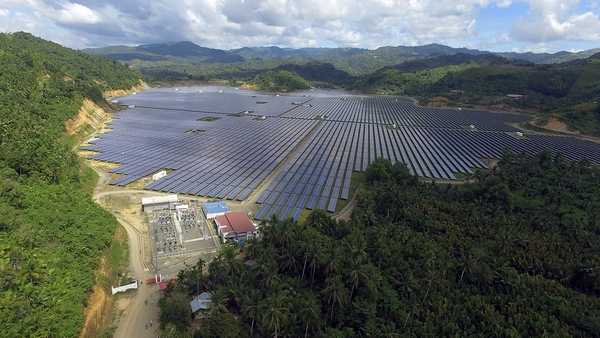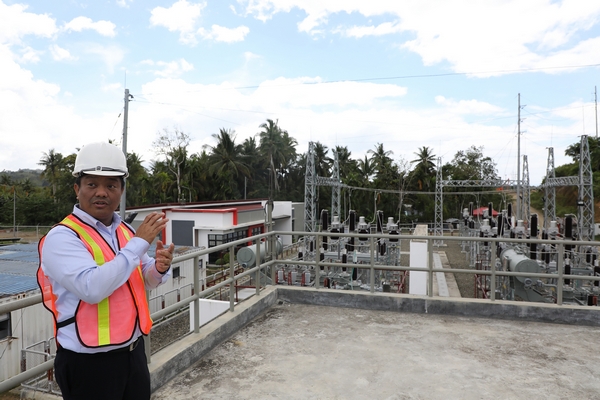
This is an aerial view of the 73-hectare First Toledo Solar Energy Corp.’s solar power plant in Barangay Talavera, Toledo City. CDN DRONE file PHOTO
(SECOND OF FOUR PARTS)
In Toledo City, southwest of Cebu, a solar power plant stands on a 73-hectare property in Barangay Talavera.
The First Toledo Solar Energy Corp. (FTSEC) was constructed in October 2015 by Citicore Power Inc. (CPI) at a cost of P4 billion.
The facility, which began to dispatch power to the National Grid Corporation of the Philippines (NGCP) in June 2016, is located just 800 meters from NGCP’s Calung-Calung substation.
It remains the only operating solar power plant in Cebu although there had been efforts in the past by investors to set up similar power facilities in the province.

Edwin Josef, Citicore Power Inc. vice president for operations, explains how the solar power plant in Barangay Talavera, Toledo City, operates during a CDN tour of the facility in February this year. This power substation will link the solar power from the plant to the Visayas grid.
In 2016, the Department of Energy (DOE) issued a service contract to Menlo Renewable Energy Corp. for the development of a 60-megawatt (MW) solar power plant amid plans by MRC Allied Inc., Menlo’s listed parent company, to establish a solar power plant in a 160-hectare industrial estate in the southern city of Naga.
Including FTSEC, Menlo was then the fourth solar plant project awarded by DOE in Cebu.
The two others were the proposed 25-MW CeKo Solar Farm Systems Corp. in Barangays Tominjao and Pajo in Daanbantayan town and the 15-MW Bogo solar power project by Sun Premier Philippine Corp. in Bogo City, both located in northern Cebu.
DOE later issued a termination letter to CeKo for non-compliance of the Milestone Approach and the Renewable Energy Safety, Health and Environment Rules and Regulations.
In June 2017, Menlo released a statement saying that their 60-MW proposed solar power project in Naga City was at the pre-development stage and disclosed that they were investing P3 billion for the project.
FTSEC
On the part of FTSEC, the company decided to invest in solar power in Cebu due to the island’s growing power demand, said CPI vice president for operations Edwin Josef in a talk with Cebu Daily News.
“Cebu is where most of the load is located in Visayas. There are a lot of solar power plants being constructed in Negros. But there is no demand there. The load is here in Cebu where there are increasing investments and industries,” he said.
Although the FTSEC’s rated capacity is 60 MW on typical days, it has a dependable capacity of only 48 MW which could go as low as 17 MW on cloudy and rainy days.
But among the several types of renewable energy sources, solar power is the fastest to establish, Josef said.
“Solar power plants are very easy, as long as your materials are ready and prepared. As fast as six months, you can already finish constructing a solar power plant,” he explained.
Solar power plants are built on huge, relatively flat spaces at approximately one hectare for every one megawatt of solar power, said Josef.
The area should also be one where solar panels are exposed to the path of the sunlight from sunrise to sunset and where there are no obstructions.
The Philippines which is near the equator is very conducive for solar power projects, said Josef, an electrical engineering graduate of the University of the Philippines in Diliman.
“It’s a fact that climate change is causing catastrophic incidents around the world. By doing renewable energy, we are helping to stop that,” he said.
CPI is a sister company of Megawide Construction Corp. — the Filipino engineering firm behind the construction of the newly inaugurated P17.5-billion Mactan-Cebu International Airport (MCIA) Terminal 2.
Advantages
While CPI has yet to earn a significant return of investment from its solar power plant in Cebu, the company remains optimistic that renewables are the way to go.
Among the advantages of solar, according to Josef, is the minimal amount of effort involved in its maintenance.
With solar power plants, there are no moving parts that need to be lubricated and checked unlike diesel and hydropower plants that have motor parts and turbines which require regular check-ups to prevent wear and tear.
They only need to be sprayed with water four times a year to remove dust and other debris that may settle on the panels; or even lesser with frequent rains.
On apprehensions that solar power is expensive, Josef said that the price of materials have been going down on a global scale especially in recent years.
Almost half of the total cost of solar power plants goes to the purchase of solar panels. On average, solar panels can last more than 25 years.
FTSEC has a total of 193,440 panels.
The cost of electricity generated by solar power is also getting cheaper, according to Josef, with prices now down to P3.50 per kilowatt hour (kWh) from P5 per kWh years before.
Electricity produced by coal, which is the most common source of power, is at P3 per kWh.
“Solar also doesn’t produce hazardous wastes. Burning of fossil fuels produces carbon monoxide. Aside from air pollution, there is also noise pollution. With solar, there is hardly any sound. There is just a low humming that can be heard in the transformers,” Josef said.
CPI is now looking into other forms of renewable energy products for Cebu and the rest of the Visayas.
Among the sources that they are eyeing are biomass and hydropower, said Josef.
(To be continued)

